Publishing FAQs
When publishing components, you may have specific questions that need to be answered so that you can format your content in the best way for your customers.
![]() Read answers to the following questions:
Read answers to the following questions:
- I'm using profiling attributes, how do I produce the version I need?
- How do I publish a previous version of a component?
- What publishing configurations does Inspire provide?
- What's the difference between a Publish and Export configuration?
- When I'm publishing a map, can I apply a DitaVal file?
- Do I have to validate my XML content?
- Can I create a publishing job to use over and over again?
- Can I import the published deliverable back into Inspire automatically?
- How do I know the name of my publishing job?
- Can I track my publishing jobs?
- How do I access the published output?
- How do I customize the published output?
- Why did my publishing job fail?
- Can I create a report to see how often a map is published?




I'm using profiling attributes, how do I produce the version I need?
- You can choose filtering options when you publish content that you've assigned profiling attributes to.
- To learn about applying profiling attributes, read Use profiling attributes.
- The filtering options you use are explained in the publishing steps.


How do I publish a previous version of a component?
- If you have a snapshot of a previous version, you can use the Publish option from the snapshot's context menu.
- You can use the filtering options when you publish a snapshot to re-create a version you published in the past.
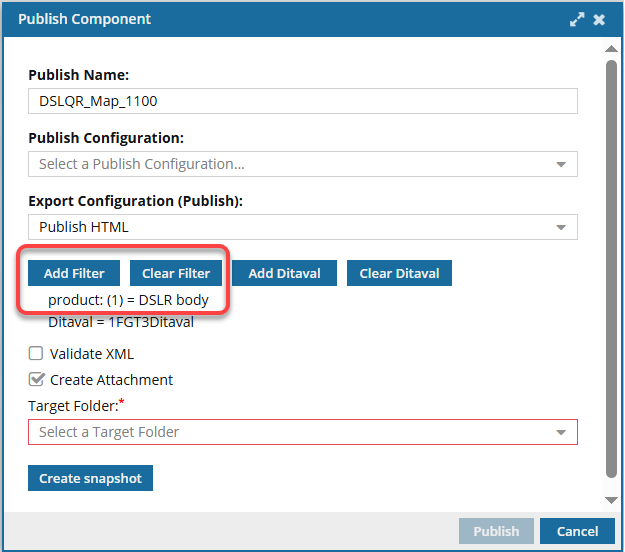
 You may not be able to re-create a previous version if any of the following changes occur:
You may not be able to re-create a previous version if any of the following changes occur:If content was removed from Inspire, the content may not appear in the deliverable, whether you use filtering or not.
If your stylesheets change, the deliverable won't look the same as it did before.
- Follow the steps in Publish a previous version from a snapshot

What publishing configurations does Inspire provide?
When you want to publish content from the Components browser you can tell Inspire how to transform it using two options:
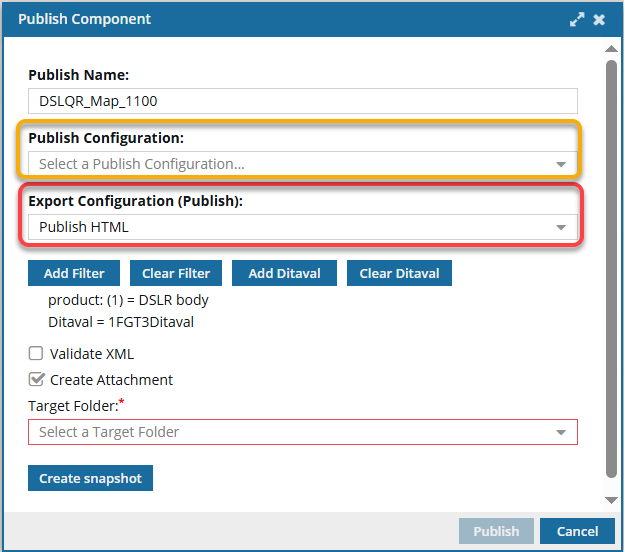
- Publish Configuration—You use this option to identify the publish settings you want to use. This configuration is created by an administrator and may include settings such as:
- A default Publish Name
- Skip or validate XML in the components you want to publish
- Profiling filters
- Optionally, an administrator can also specify which Export Configuration (Publish) option to use.
 The same settings on the Publish Component screen can also be set by an administrator in the Publish Configuration.
The same settings on the Publish Component screen can also be set by an administrator in the Publish Configuration.- If you select options on the Publish Component screen, your settings are used even if they are in conflict with the Publish Configuration that an admin creates.
- If you select options on the Publish Component screen that don't conflict with the Publish Configuration that an admin creates, then both sets of options are used.
- Export Configuration (Publish)—You use this option as you normally would, to run the actual export process for publishing content. For example, you can choose options similar to:
- HTML
- Zoomin
 The user's configuration choice is used to create the output, even if it is in conflict with the Export Configuration (Publish) set in the Publish Configuration by an administrator.
The user's configuration choice is used to create the output, even if it is in conflict with the Export Configuration (Publish) set in the Publish Configuration by an administrator.
 For some customers, Inspire provides a Publish Configuration and a publishing plug-in for DOCX.
For some customers, Inspire provides a Publish Configuration and a publishing plug-in for DOCX.- DOCX is the file format used by Microsoft Word to store documents.
- If the DOCX publishing option is supported for your organization, when you publish a component, on the Publish Component screen, you can select the Publish Docx option.
- If published successfully, you can download a deliverable in the DOCX file format that you can open in Microsoft Word.


What's the difference between a Publish and Export configuration?

- Publish Configuration—You use this option to identify the publish settings you want to use. This configuration is created by an administrator and may include settings such as:
- A default Publish Name
- Skip or validate XML in the components you want to publish
- Profiling filters
- Optionally, an administrator can also specify which Export Configuration (Publish) option to use.
 The same settings on the Publish Component screen can also be set by an administrator in the Publish Configuration.
The same settings on the Publish Component screen can also be set by an administrator in the Publish Configuration.- If you select options on the Publish Component screen, your settings are used even if they are in conflict with the Publish Configuration that an admin creates.
- If you select options on the Publish Component screen that don't conflict with the Publish Configuration that an admin creates, then both sets of options are used.
- Export Configuration (Publish)—You use this option as you normally would, to run the actual export process for publishing content. For example, you can choose options similar to:
- HTML
- Zoomin
 The user's configuration choice is used to create the output, even if it is in conflict with the Export Configuration (Publish) set in the Publish Configuration by an administrator.
The user's configuration choice is used to create the output, even if it is in conflict with the Export Configuration (Publish) set in the Publish Configuration by an administrator.


When I'm publishing a map, can I apply a DitaVal file?
Yes, if you are publishing a map component.
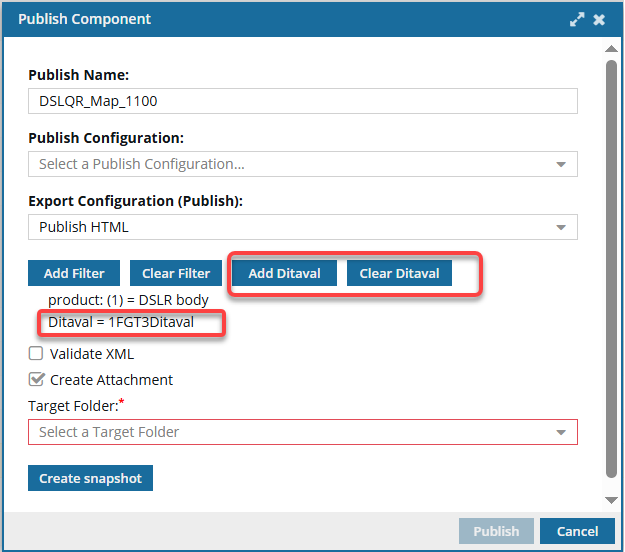
 Ditaval files specify the conditions to include and exclude when you generate your output. They ensure that conditions are always applied consistently to generated output. DitaVal files are useful if you're using conditional attributes extensively in your documentation.
Ditaval files specify the conditions to include and exclude when you generate your output. They ensure that conditions are always applied consistently to generated output. DitaVal files are useful if you're using conditional attributes extensively in your documentation.
- The DitaVal file must exist in Inspire. If you want to publish with a Ditaval file, make sure you have imported it into Inspire already. Follow the steps in: Import components.
- Only when you're publishing a map can you optionally select a DitaVal file.
- After selecting the Add Ditaval button, you can select the checkbox for one DitaVal file that exists in Inspire.



Do I have to validate my XML content?
- You can choose to optionally validate content before you publish.
- Keep in mind that your publishing job might fail if Inspire can't generate a valid XML document


Can I create a publishing job to use over and over again?
You can create publishing profiles to make it easier to re-publish content.
- A publishing profile lets you specify a component, a default Publish Name, an export configuration, filters, and XML validation options once so that you can use it repeatedly.
- To learn more about publishing profiles, read Work with publishing profiles.
- If you want to re-run a job you've already published without changing any of the details, you can also open Publish Server. Just select the job and click Re-run publish
 .
.


Can I import the published deliverable back into Inspire automatically?
Yes. When you select publishing options on the Publish Component screen, select Create Attachment.
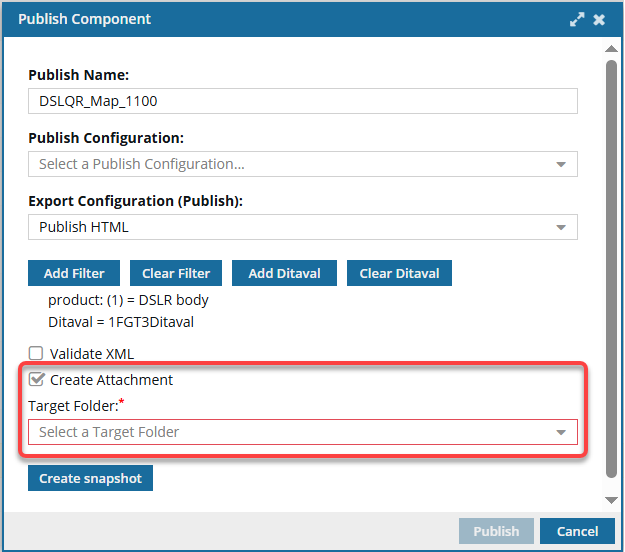
After the publishing job completes successfully:
- A copy of the published deliverable is imported back into Inspire automatically as a binary file.
- Inspire saves the deliverable in the Target Folder you select.
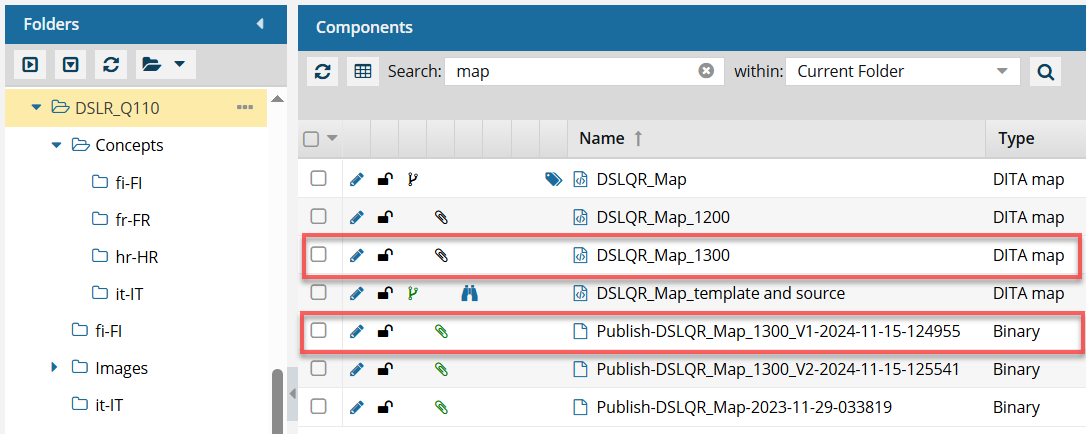
The file is named using the following format: Publish-{ComponentName}-YYYY-MM-DD-HHHHMM.
- A relationship between the component you published and the deliverable that was imported is created.
- In the Component's Browser, the component you published now has
 a black paperclip before its name. This indicates it references another component as an attachment.
a black paperclip before its name. This indicates it references another component as an attachment. - In the Component's Browser, the published deliverable has
 a green paperclip before its name. This indicates it is referenced by an another component as an attachment.
a green paperclip before its name. This indicates it is referenced by an another component as an attachment. - For more information on attachment relationships, read See component attachments.
- In the Component's Browser, the component you published now has
 For Publishing Profiles, this option is available when you right-click a publishing profile, and select Publish. On the Publish Component screen you can select the Create Attachment option to import the deliverable.
For Publishing Profiles, this option is available when you right-click a publishing profile, and select Publish. On the Publish Component screen you can select the Create Attachment option to import the deliverable.
How do I know the name of my publishing job?

Inspire creates a Publish Name in the following ways:
Publish Name is the component's File Name without the GUID IF:
- You select a single component to publish and you don't select a Publish Configuration.
- You select a single component to publish and the Publish Configuration you select does not have a default Publish Name.
Publish Name is defined in the Publish Configuration IF:
- You select a single component to publish and the Publish Configuration you select has a default Publish Name.
- You select multiple components to publish and the Publish Configuration you select has a default Publish Name.
Publish Name is empty IF:
- You select multiple components to publish and the Publish Configuration you select does not have a default Publish Name.
- You can enter your own Publish Name with or without tokens.
For example, if you selected a component named Chpt1_Charge_battery_2696b8b3-0040-463b-abad-6aa200a4fa5e.xml, and use  the Options menu to select Publish:
the Options menu to select Publish:
- By default, the value in the Publish Name field is Chpt1_Charge_battery.
- You see this Publish Name on the Publish portal in the Title column.
- Optionally, you can change the Publish Name to a different set of characters.
- Use 1000 characters or less
- Use underscores (_) instead of spaces
If you leave Publish Name empty and are publishing one component, Inspire uses the component's File Name without the GUID.
- If you leave Publish Name empty and are publishing multiple components, Inspire leaves the Publish Name empty.
 A Publish Name can also contain a token to configure how your Inspire content is sent to the Publish portal to reduce the amount of manual entry.
A Publish Name can also contain a token to configure how your Inspire content is sent to the Publish portal to reduce the amount of manual entry.
- You can use characters reserved for XPath and system variables in Publish Name.
- You can specify 1000 characters of tokens. However, if the resolved tokens use more than 1000 characters, they are truncated.
Examples of ways you can use a token in the job's Publish Name field:
- To add the name of the MyMap component, use
{$componentname} Example Publish Name = MyMap
Example Publish Name = MyMap - To add the topic title of the MyMap component, use
{$title} Example Publish Name = UserManual
Example Publish Name = UserManual - To add the file name of the MyMap component, use
{$filename} Example Publish Name = MyMap_ceb80930-0712-48d2-92a5-9c2ee7d2ff7d.xml
Example Publish Name = MyMap_ceb80930-0712-48d2-92a5-9c2ee7d2ff7d.xml - To add the current date and time to the job name for MyMap, use
{$datetime} Example Publish Name = MyMap2024-04-30-111017
Example Publish Name = MyMap2024-04-30-111017 - To add the name of the user who created the publishing job for MyMap, use
{$username} Example Publish Name = MyMapjanedoe@mycompany.org
Example Publish Name = MyMapjanedoe@mycompany.org - To add the code for the language used in the component MyMap, use
{$langcode} Example Publish Name = MyMapen-US
Example Publish Name = MyMapen-US - To add the name of the language used in the component MyMap, use
{$langname} Example Publish Name = MyMapEnglish
Example Publish Name = MyMapEnglish  If you need a system variable that isn't in the list of examples, contact your Inspire support representative.
If you need a system variable that isn't in the list of examples, contact your Inspire support representative.
- To add the name of the MyMap component, use
- This lets you pull in data so you don't have to type it in every time you send the component out for publishing.
- The Publish Name you use on the Publish Component screen is shown on the Publish portal in the Title column.
- If you use a token in Publish Name, and Inspire can resolve it, the token appears in the following places with the token replaced by actual data:
- On the Publish portal in the Title column.
- In the deliverable name using the following format: Publish-{ComponentName}{token}-YYYY-MM-DD-HHHHMM.
If you add a variable to the publishing job Publish Name that XPath can't find, Inspire adds the unknown variable as text to all names and notifications except for the deliverable name.
For steps on creating tokens, refer to the following topics:
 Keep the following naming issues in mind:
Keep the following naming issues in mind:
- The job's Publish Name is not the same as the deliverable (published content) name.
- You can create whatever job Publish Name you want.
- Deliverables are named by Inspire using the following format: Publish-{ComponentName}-YYYY-MM-DD-HHHHMM.
- When you publish from a Publishing Profile, you see:
- The Publish Name you use on the Publishing Profile tab is shown on the Publish portal in the Profile column.
- The Publish Name you use on the Publish Component screen is shown on the Publish portal in the Title column


Can I track my publishing jobs?
You can use the Publish portal to see job status and histories, download files related to a job, and re-publish content from an existing job.
- To learn about job management, read Welcome to Publish Server.
- Open Publish Server from a link in the following places:
- In your
 notification after you submit a publishing job or Open and manage messages on the Notifications tab
notification after you submit a publishing job or Open and manage messages on the Notifications tab - On the
 Publishing tab by clicking
Publishing tab by clicking  Go to Publish Server
Go to Publish Server
- In your
- For the HTML publishing format, you download a ZIP file that includes multiple files:
- For the following publishing formats, you download a single standalone file:
- DOCX (the file format used by Microsoft Word to store documents)
- DocBook PDF
- DOCBOOK HTML
- When you use the Zoomin publishing option, you must open the notification and use the link to go to the Zoomin site.
- For some customers, Inspire provides a publishing configuration and a publishing plug-in for DOCX
- If the DOCX publishing option is supported for your organization, when you publish a component, on the Publish Component screen, you can select the Publish Docx option.
- If published successfully, you can download a deliverable in the DOCX file format that you can open in Microsoft Word.
- For custom publishing options, you can configure the publishing deliverables.

How do I access the published output?
When a publishing job has a Status of Success, you can download the completed publication in the following places:
- From the Publish Server dashboard. Read Open Publish Server.
- In Inspire from the notification. Read Open and manage messages on the Notifications tab.
- From the email notification in your inbox.
 Tips and tricks
Tips and tricks
- If you want to download the run log and artifact files, follow the steps in Download publishing job files.
- When you download a publication, the file is saved in your browser's download tray.
- For the following Inspire publishing formats, you download a ZIP file that includes multiple files:
- HTML
- For the following publishing formats, you download a single standalone file:
 DocX (the file format used by Microsoft Word to store documents)
DocX (the file format used by Microsoft Word to store documents)- DocBook PDF
- DocBook HTML
- When you use the Zoomin publishing option, you must open the notification and use the link to go to the Zoomin site.
- For custom publishing options, you can configure the publishing deliverables

How do I customize the published output?
As an administrator, you can define what format you want to publish content in using a publish export configuration.
- You can select a transformation configuration provided by Inspire or use your own plug-in to transform DITA content into formats such as PDF or HTML.
- You can also create a new export configuration for publishing and add configurations. Administrators can follow the steps in Create a publish export configuration.


Why did my publishing job fail?
- You receive an internal and email notification describing any issues found during the publication process.
- Read Open and manage messages on the Notifications tab


Can I create a report to see how often a map is published?
Yes, you can gather metrics about who has published a map, how long it took to create the map's deliverables, and if it was successful or had issues.
 Important notes:
Important notes:
![]() You can create a Publish Activity report only for a component that has a Type of Map.
You can create a Publish Activity report only for a component that has a Type of Map.
- If you select a component that isn't a map, in the Reports menu, the Publish Activity option is not available.

 The report only contains publishing events that occur on or after March 13, 2025.
The report only contains publishing events that occur on or after March 13, 2025.
- The Publishing activity report feature was not available before the release of Inspire 2025.1.2.0 and any publishing events before those dates aren't included in the report.
 In the top right corner menu, click
In the top right corner menu, click  Get more Help to see the version of the app you're running.
Get more Help to see the version of the app you're running. - If the map hasn't been published after the release of Inspire 2025.1.2.0, the report tells you there is no publish information, even if you can see it by opening the Details and selecting the History tab.
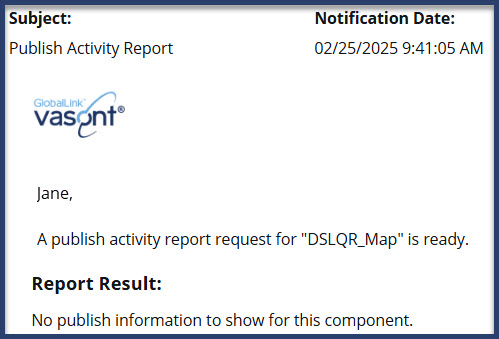

You can create a list of details about when a map or Bookmap component was published.
- You can create a Publish Activity Report in the following places:
- Components browser using
 the Options menu or the right-click menu
the Options menu or the right-click menu - A project's Contents pane using
 the Options menu or the right-click menu
the Options menu or the right-click menu - Selected Components pane using
 the Reports menu.
the Reports menu. Selecting multiple components and then selecting the Publish Activity option creates multiple reports. You receive a separate notification and report for each map selected.
Selecting multiple components and then selecting the Publish Activity option creates multiple reports. You receive a separate notification and report for each map selected.
- Components browser using
- You can see the following information in the Publish Activity report:
- Component details: The component ID which is a link you can click to go to it, the name of the map, and the path to where it's stored.
- User details: The name of the user who requested the publication.
- Publishing details: The day and time of the request, when it was started, and when it completed. You can use these details to see how long it takes to publish the map.
- Status details: See if the publishing process was a success or if it failed.
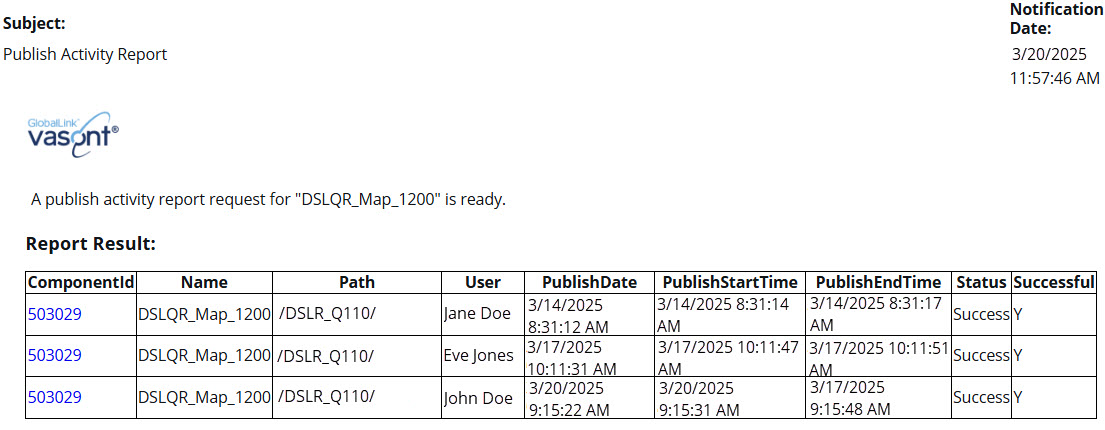
The report contains a table with the following columns:
- ComponentId
- Name
- Path
- User
- PublishDate
- PublishStartTime
- PublishEndTime
- Status
- Successful